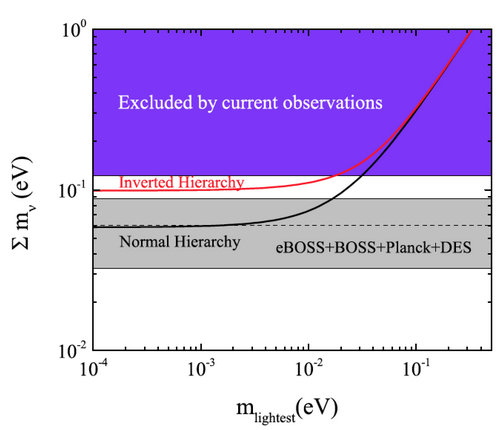|
|
| eBOSS Releases New Results: NAOC is Leading the Science Forecast Project |
TEXT SIZE: A A A |
eBOSS, the largest ongoing galaxy survey in the world, has recently published first science papers on key journals of astronomy including MNRAS, ApJS and A&A. Gong-Bo Zhao’s team at NAOC is leading a science project of the eBOSS collaboration, providing an official cosmological analysis based on the design of eBOSS. According to this new analysis, eBOSS will be able to test the dynamics of dark energy at three sigma significance level. Gong-Bo Zhao’s research team at NAOC has recently led a project of cosmological forecast for the extended Baryon Oscillation Spectroscopic Survey (eBOSS; 2014-2020), which is part of the SDSS-IV project. Based on the survey design and parameters, Zhao et al. have forecasted the ability of eBOSS on the measurement of Baryonic Acoustic Oscillations (BAO), Redshift Space Distortions (RSD) and cosmological parameters including neutrino masses. This study shows that eBOSS has the ability to probe the dynamics of dark energy at 3 sigma confidence level (Gong-Bo Zhao et al. have reported a hint of dark energy dynamics at 2.5 sigma significance using the BOSS data; Zhao et al., 2012, PRL, 109, 171301). Moreover, eBOSS will also be capable to distinguish between the Normal Hierarchy and Inverted Hierarchy of neutrino masses, which is key to the search for new physics beyond standard model of particle physics. This result has been published on MNRAS on Feb 11th, 2016 (Zhao et al., 2016, MNRAS, 457, 2377, arXiv: 1510.08216), together with a series of other papers released by the eBOSS collaboration including the eBOSS overview paper (Dawson et al., 2016, AJ, 151, 44), eBOSS target selection papers (Myers et al., 2015, ApJS 221, 27; Raichoor et al., 2016, A&A 585, A50). Gong-Bo Zhao’s team includesYuting Wang (postdoc), Dandan Wang (PhD student), Yuecheng Zhang (Master student), Hanyu Zhang (visiting student) and Pengyuan Gao (visiting student). Profs. Xu Zhou and Hu Zou from NAOC and Charling Tao (Tsinghua University) have also contributed to this research. This work was supported by the Strategic Priority Research Program "The Emergence of CosmologicalStructures" of the Chinese Academy of Sciences, and by NAOC as well. Fig 1. The forecasted BAO sensitivity of eBOSS (filled circles) in comparison with the current BOSS measurements (unfilled symbols). The shaded bands illustrate theoretical prediction of a range of dark energy models. This figure is adapted from Zhao et al., 2016, MNRAS, 457, 2377, arXiv: 1510.08216. Fig 2. The forecasted 68 and 95% CL constraints on dark energy EoS parameters using BOSS with and without eBOSS data combined. This figure is adapted from Zhao et al., 2016, MNRAS, 457, 2377, arXiv: 1510.08216.  Fig 3. The forecasted sensitivity of eBOSS on neutrino mass constraint. This figure is adapted from Zhao et al., 2016, MNRAS, 457, 2377, arXiv: 1510.08216. Facts of BOSS and eBOSS surveys: The Baryon Oscillation Spectroscopic Survey (BOSS, 2009-2014), part of the SDSS-III project, was the largest spectroscopic galaxy surveys in past five years. Based on a 2.5-metre optical telescope, BOSS has surveyed roughly 25% of the whole sky, achieving a 1% accuracy of the BAO distance measurement for the first time using 1 million spectra of galaxies at an effective redshift z~0.6. The successor of BOSS, The extended Baryon Oscillation Spectroscopic Survey (eBOSS, 2009-2014) started in July of 2014 and will complete its survey in 2020. Compared to BOSS, eBOSS will map the Universe at higher redshifts (in the redshift range of 0.6<z<2.2), using more types of galaxy including Luminous Red Galaxies (LRGs), Emission Line Galaxies (ELGs) and quasars (QSOs). According to the official eBOSS forecasts led by the Applicant (Zhao et al., 2016), eBOSScan achieve a precision of 1% (LRGs), 2.2% (ELGs) and 1.6% (QSOs), respectively, for BAO distance measurements.eBOSS will provide robust constraints on dark energy and neutrino masses. NAOC officially joined SDSS-IV in 2013 as a full institutional member. Besides eBOSS, SDSS-IV includes the IFU survey MaNGA and the Milky Way survey APOGEE-II. NAOC scientists are working on all these three surveys, and have obtained important results using the early data. |
|
Attachment:
|
|













